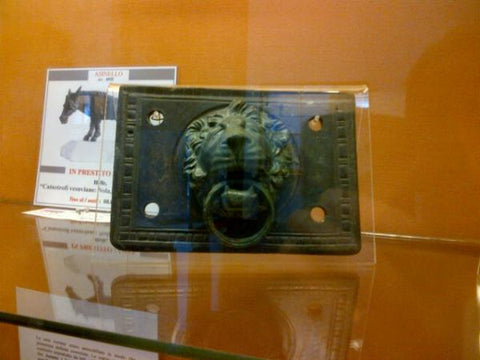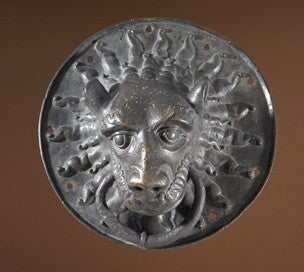
A Brief History of the Door Knocker
The door knocker is quintessential look for an English Front door although the first door knockers were thought to be found in Ancient Greece.
I was delighted to come across a beautiful example of a brass Lions Head knocker at the Naples Museum that would not look out of place gracing a London Mews today. Although very beautiful, the history is a little grimmer, thought to be rings through which slaves were chained to greet guests at fine Roman houses (something people with teenage children might recognise).

The English have very much taken the knocker to their heart, in fact so much so they appear both at the heart of our Government, with the most recognise symbol of Downing St being the very regal Lion Door Knocker on the door of number 10, to being mentioned in one of the most loved of all English Literature, A Christmas Carol;
‘Now, it is a fact, that there was nothing at all particular about the knocker on the door, except that it was very large. It is also a fact, that Scrooge had seen it, night and morning, during his whole residence in that place; also that Scrooge had as little of what is called fancy about him as any man in the city of London, even including — which is a bold word — the corporation, aldermen, and livery. Let it also be borne in mind that Scrooge had not bestowed one thought on Marley, since his last mention of his seven years’ dead partner that afternoon. And then let any man explain to me, if he can, how it happened that Scrooge, having his key in the lock of the door, saw in the knocker, without its undergoing any intermediate process of change — not a knocker, but Marley’s face.’
Whilst many styles exist, most people are keen to keep the period look of their front door, taking great care to choose fittings that are both practical and in keeping with the architectural style of their home. The earliest knockers tend to be cast iron, made by the local blacksmith to local patterns and traditions. These tended to be fairly plain, with wrought rings on back plates being a popular choice.
Good luck knockers are also more common in country properties, with cats, clover and all manner of good luck charms. The hand knocker is thought to be a symbol of the Hand of Fatima, a talisman to protect a house from evil.

However as early as 1600, people were keen to add a flourish to their homes. This example held at the British Museum is dated to 1600 and is cast bronze.
The Georgian period saw an explosion of styles of knocker, from ancient Greek goddess’s, Adams style urns to Egyptian Revival Sphynx, mostly now in either cast brass, or the posher bronze.
With the founding of foundry’s like Kendrick in 1790 for the first time more modest homes could also adorn their homes in the latest styles. Like many other founders they used many decorative themes, bringing "art metal work" to a wide market. Many beautiful examples of Kendrick’s work are still available in rec yards, antique fairs and boot sales and there are some stunning (and some not so stunning) reproductions around.
Having worked in reclaim for many years, we rarely see a front door with all its original furniture. As the postal service was set up so letter plates were installed, more sophisticated locks were added and as more switched to door bells, so knockers were removed. Today we are fortunate that there are many ways to recapture the grandeur of our doors.
The first place to start is to assess what you remains on your door. Are you matching the knocker to existing pieces or are starting from scratch? If you are adding to existing pieces, care must be taken to ‘match’ with the existing furniture. Most modern brass is much more yellow than the rich tones of antique brass. It also tends to be lacquered, so will not patina in the same way as older pieces. Most companies that specialise in period properties should have a range of knockers in the richer brass that are also unlacquered. As most knockers fit in between the panels of your door, size may restrict your choices. Georgian doors tend to have slimmer mullions so can be tricky to find knockers for. Again, most companies should be able to advise if size is an issue. Finally have a look up your street, are they any originals left that can give you a clue as to what would have been there. They will not all be identical, but will give some insight and maybe even some inspiration. But if all else fails, a knowledgeable retailer should be able to give you some pointers given the age of house, location and your requirements, Most are happy to advise and are an untapped source of knowledge regarding the evolution of front door styles having often reclaimed many of their pieces in situ.


Comments
Leave a comment